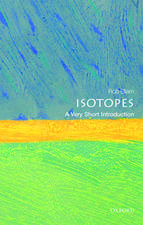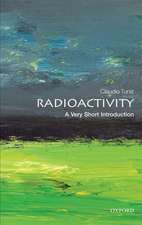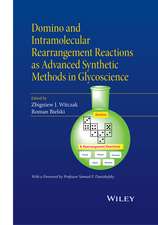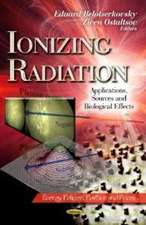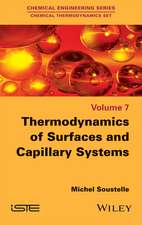The Study of Fast Processes and Transient Species by Electron Pulse Radiolysis: Proceedings of the NATO Advanced Study Institute held ay Capri, Italy, 7–18 September, 1981: Nato Science Series C:, cartea 86
Editat de J.H. Baxendale, F. Busien Limba Engleză Paperback – 19 oct 2011
Din seria Nato Science Series C:
- 24%
 Preț: 797.66 lei
Preț: 797.66 lei - 18%
 Preț: 957.62 lei
Preț: 957.62 lei - 18%
 Preț: 957.13 lei
Preț: 957.13 lei - 18%
 Preț: 1227.52 lei
Preț: 1227.52 lei -
 Preț: 396.40 lei
Preț: 396.40 lei -
 Preț: 403.75 lei
Preț: 403.75 lei - 18%
 Preț: 1239.37 lei
Preț: 1239.37 lei - 18%
 Preț: 1236.51 lei
Preț: 1236.51 lei - 18%
 Preț: 1231.78 lei
Preț: 1231.78 lei - 18%
 Preț: 1229.10 lei
Preț: 1229.10 lei - 18%
 Preț: 1835.21 lei
Preț: 1835.21 lei - 24%
 Preț: 1076.36 lei
Preț: 1076.36 lei -
 Preț: 390.46 lei
Preț: 390.46 lei -
 Preț: 369.63 lei
Preț: 369.63 lei - 18%
 Preț: 1232.41 lei
Preț: 1232.41 lei -
 Preț: 394.51 lei
Preț: 394.51 lei - 18%
 Preț: 1226.24 lei
Preț: 1226.24 lei - 18%
 Preț: 1845.80 lei
Preț: 1845.80 lei -
 Preț: 399.88 lei
Preț: 399.88 lei -
 Preț: 384.28 lei
Preț: 384.28 lei -
 Preț: 390.88 lei
Preț: 390.88 lei -
 Preț: 381.19 lei
Preț: 381.19 lei - 18%
 Preț: 1848.64 lei
Preț: 1848.64 lei - 18%
 Preț: 951.14 lei
Preț: 951.14 lei - 18%
 Preț: 1230.35 lei
Preț: 1230.35 lei - 18%
 Preț: 1236.51 lei
Preț: 1236.51 lei -
 Preț: 401.03 lei
Preț: 401.03 lei -
 Preț: 406.25 lei
Preț: 406.25 lei - 18%
 Preț: 1230.84 lei
Preț: 1230.84 lei -
 Preț: 418.34 lei
Preț: 418.34 lei - 18%
 Preț: 1223.74 lei
Preț: 1223.74 lei
Preț: 410.79 lei
Nou
Puncte Express: 616
Preț estimativ în valută:
78.60€ • 82.07$ • 65.06£
78.60€ • 82.07$ • 65.06£
Carte tipărită la comandă
Livrare economică 31 martie-07 aprilie
Preluare comenzi: 021 569.72.76
Specificații
ISBN-13: 9789400978546
ISBN-10: 9400978545
Pagini: 656
Ilustrații: 660 p.
Dimensiuni: 156 x 244 x 34 mm
Ediția:Softcover reprint of the original 1st ed. 1982
Editura: SPRINGER NETHERLANDS
Colecția Springer
Seria Nato Science Series C:
Locul publicării:Dordrecht, Netherlands
ISBN-10: 9400978545
Pagini: 656
Ilustrații: 660 p.
Dimensiuni: 156 x 244 x 34 mm
Ediția:Softcover reprint of the original 1st ed. 1982
Editura: SPRINGER NETHERLANDS
Colecția Springer
Seria Nato Science Series C:
Locul publicării:Dordrecht, Netherlands
Public țintă
ResearchCuprins
Absorption of Energy From Ionizing Radiation.- 1. X-rays and ?-rays.- (a) Photoelectric effect.- (b) Compton effect.- (c) Pair production.- 2. Electrons.- (a) Excitation and ionisation of molecules.- (b) Emission of radiation.- (c) Electron range.- (d) Low energy electrons.- 3. Heavy Positive Particles.- (a) High energy.- (b) Low energy.- 4. Neutrons.- References.- Basics of Radiation Chemistry.- Spacial Distribution and Reaction Kinetics.- 1. Charge Particle Tracks and Track Densities.- 2. Spur Reactions.- 3. Non-Homogeneous Kinetics.- Time Scale of Events in a Liquid.- 1. Development.- 2. Summary of Time Scale.- References.- Sources of Pulsed Radiation.- 1. Introduction.- 2. Types of Pulsed Radiation Sources.- 2.1. Microwave linear accelerators.- 2.2. Febetrons.- 2.3. Other sources of pulsed radiation.- 3. Physical Dosimetry for Pulses Sources.- References.- Chemical Dosimetry of Pulsed Electron and X-Ray Sources in the 1-20 MeV Range.- 1.1. Units of Absorbed Dose.- 1.2. Units of Radiation Chemical Yield.- 2.1. Principles of Chemical Dosimetry.- 2.2. The Ferrous Sulphate or Fricke Dosimeter.- 2.3. The “Super Fricke Dosimeter”.- 2.4. Other Dosimeters Suitable for High Intensity Pulsed Sources.- 3.1. Dosimetry by the Measurement of Fugitive Species.- 3.2. Sources of Error.- 1. Correction due to pulse duration.- 2. Correction for response time of system.- 3.3. The Thiocyanate Dosimeter.- 3.4. The Hydrated Electron Dosimeter.- 3.5. The Ferrocyanide Dosimeter.- References.- Optical Monitoring Techniques.- 1. General Considerations.- 2. Optical Systems.- 2.1. Lenses.- 2.2. Mirrors.- 2.3. Light-Sources.- 2.4. Monochromators.- 3. Monitoring Techniques.- 3.1. Photodetectors.- 3.2. Photomultipliers.- 3.3. Photodiodes.- 3.4. Detector circuits.- References.- ConductivityMonitoring Techniques.- Electrical Principles.- Limitations.- Experimental Set-ups.- Chemical Examples.- Conclusion.- References.- Polarography Monitoring Techniques.- Experimental Section.- Examples.- Conclusion.- References.- The Microwave Absorption Technique For Studying Ions and Ionic Processes.- Experimental.- General.- Circuit components.- Irradiation cells.- Irradiation conditions.- Data Reduction.- Reflection cell.- Resonant cavity cell.- The yield-mobility product.- Application and Comparison with other Techniques.- References.- EPR and NMR Detection of Transient Radicals and Reaction Products.- Time Resolved EPR.- Pulsed EPR.- Time resolved spectra.- Time sweep.- Free induction decay.- NMR in Radiation Chemistry.- References.- Radical Ions and Excited States in Radiolysis. Optically Detected Time Resolved EPR.- Method, Results and Discussion.- References.- Light Scattering Techniques for Investigation of Transients Produced in Electron Pulse Radiolysis.- Rayleigh Scattering.- Raman Scattering.- Background.- Origin of resonance enhancement.- Experimental.- Pulse radiolysis and TR3 detection.- Current activity.- References.- Data Acquisition and Analysis in Pulse Radiolysis Part is Control, Digitization, and Analysis.- 1.0. Introduction.- 2.0. Timing and Control.- 3.0. Digitisation of the Transient Signal.- 3.1. Oscilloscopes.- 3.2. Electronic digitiser.- 3.3. Diode matrix technique.- 3.4. Streak cameras.- 3.5. Pulse-probe technique.- 3.6. Counting methods.- 3.7. Computer as digitiser.- 4.0. Data Processing and Analysis.- 4.1. Initial data processing.- 4.2. Simple linear fitting.- 4.3. Iterative linear regression.- 4.4. Direct solution of kinetic equations.- 4.5. Deconvolution.- 4.6. Statistical considerations.- 5.0. Conclusion.- References.- Data Acquisitionand Analysis in Pulse Radiolysis Part II: Computerization.- 1.0. Introduction.- 2.0. Historical Survey.- 2.1. The computer revolution.- 2.2. Computers in pulse radiolysis.- 3.0. Techniques of Laboratory Computerisation.- 3.1. Computer hardware.- Minicomputers.- Microcomputers.- 3.2. Hardware Interfacing.- Camac.- GPIB.- S-100 Bus.- Ethernet.- 3.3. Operating systems.- 3.4. Programming languages.- 4.0. Some General Aspects of Design and Implementation.- 4.1. Flexibility.- 4.2. Ease of use.- 4.3. Manual control option.- 4.4. How much computerisation?.- 5.0. Conclusion.- References.- Rapid Techniques for Correcting Nanosecond Kinetic Traces for Convolution Error.- 1.0. Introduction.- 2.0. Separation of the Convolution Integral.- 3.0. Model Excitation Response Function.- 4.0. Discussion.- 5.0. Examples.- 6.0. Conclusion.- References.- Basic Radiation Chemistry of Liquid Water.- 1. Introduction.- 2. Primary Events.- 3. Experimental Evidence for Spurs.- 4. Yields of the Primary Species.- 4.1. Yields in neutral solution.- 4.2. Dependence on pH.- 5. Initial Yields.- 6. Properties of the Primary Radicals.- 6.1. Hydrated electron.- 6.2. Hydrogen atom.- 6.3. Hydroxy1 radical.- 6.4. Perhydroxyl radical.- 7. Water Radiolysis as a Chemical Tool.- 7.1. Oxidising conditions.- 7.2. Reducing conditions.- 8. Concluding Remarks.- References.- Applications of Water Radiolysis in Inorganic Chemistry.- 1. Introduction.- 2. Inorganic Free Radicals.- 3. Non-metallic Compounds.- 3.1. Oxyhalogen ions.- 3.2. Borohydride ion.- 4. Aquo-metal Ions in Unusual Oxidation States.- 5. Lanthanides and Actinides.- 6. Transition Metal Complexes.- 6.1. Electron transfer.- 6.2. Coordinated free radicals.- 6.3. Aquation of transition metal complexes.- 6.4. Change in symmetry.- 7. Concluding Remarks.- References.- Application of Pulse Radiolysis to the Study of Aqueous Organic Systems.- Reactions of OH, e-aq and H.- Hydroxyl radicals.- Hydrated electrons.- Hydrogen atoms.- Design of Experiments.- Radicals formed from OH reactions.- Radicals formed from e-aq reactions.- Radicals formed from H reactions.- Acid-base properties.- Errors.- Free Radicals Formed from Organic Compounds.- Hydrocarbons.- Halides.- Alcohol and carbonyl compounds.- Sulphur compounds.- References.- Application of Pulse Radiolysis to the Study of Molecules of Biological Importance.- One Electron Reduction Potentials.- Quinones.- Carbohydrates.- Amino Acids and Peptides.- Pyridine Compounds.- Flavins.- Haem and Haemoproteins.- Vitamin B12.- Excited States.- References.- Structure and Dynamics of Paramagnetic Transients By Pulsed EPR and NMR Detection of Nuclear Resonance.- Time Resolved EPR.- NMR Detection of Nuclear Resonance.- CIDNP and CIDEP Contributions.- References.- Transients in Low Temperature Aqueous Glasses.- 1. The Glassy State.- 2. Techniques Used in Matrix Isolation Studies.- Recombination Luminescences.- Electro Luminescences.- 3. Radiation Chemistry in Glassy Matrices.- 4. Examples of Aqueous Glasses.- 4.1. Pure ice.- 4.2. Acid glasses.- 4.3. Alkaline glasses.- 4.4. Salt glasses.- 4.5. Ethylene glycol-water glasses.- 5. The Fate of Trapped Electrons.- 6. Conclusion.- References.- Labile Species and Fast Processes in Liquid Alcohol Radiolysis.- Overall Reaction.- Major products.- Minor products.- Non-homogeneous Kinetics and Fast Processes.- Decomposition of e-s.- References.- Labile Species and Fast Processes in Liquid Alkanes.- Ionic Species.- Free ion yields.- Ions in spurs.- Kinetics.- Free Radicals.- Yields.- Reactions.- Excited States.- Yields.- References.- The Dynamics of Electrons andIons in Non-Polar Liquids.- Historical perspective.- Ionisation.- Recombination and Escape.- Correlated ion pair kinetics.- The free ion yield.- Homogeneous ion recombination.- Mobilities.- General.- Electrons.- Solvent-radical cations.- Solvent-radical anions.- Molecular ions.- Scavenging Yields.- References.- Molecular Excited States in Liquid Systems.- Primary Events during Fast Electron Bombardment.- Contribution of Pulse Radiolysis.- References.- Radiolytic Studies of Micelles and Other Aggregated Systems.- Cell Membranes.- Micelles.- Reverse Micelles.- Liposomes and Vesicles.- The Hydrated Electron.- The Hydroxy1 Radical.- Reduction of Dimensionality.- Electron Transfer Reactions.- Binding of Proteins to Vesicle Bilayers.- References.- Transients in Low Temperature Organic Glasses.- 1. Different Types of Organic Glasses.- 2. Properties of Trapped Electrons.- 2.1. The trapping process.- 2.2. Structure of trapped electrons.- 3. Reactions of Trapped Electrons.- 3.1. Reaction with scavengers.- 3.2. Reaction with cations.- 4. Cation Radicals.- References.- The Use of Pulse Radiolysis to Study Transient Species in the Gas Phase.- 1. Introduction.- 2. Excited States.- 2.1. Pure rare gases.- 2.2. Rare gases containing additives.- 3. Charged Species.- 3.1. Recombination.- 3.2. Ion-molecule reactions.- 3.3. Electron capture.- 4. Atoms and Radicals.- References.- Index of Subjects.

